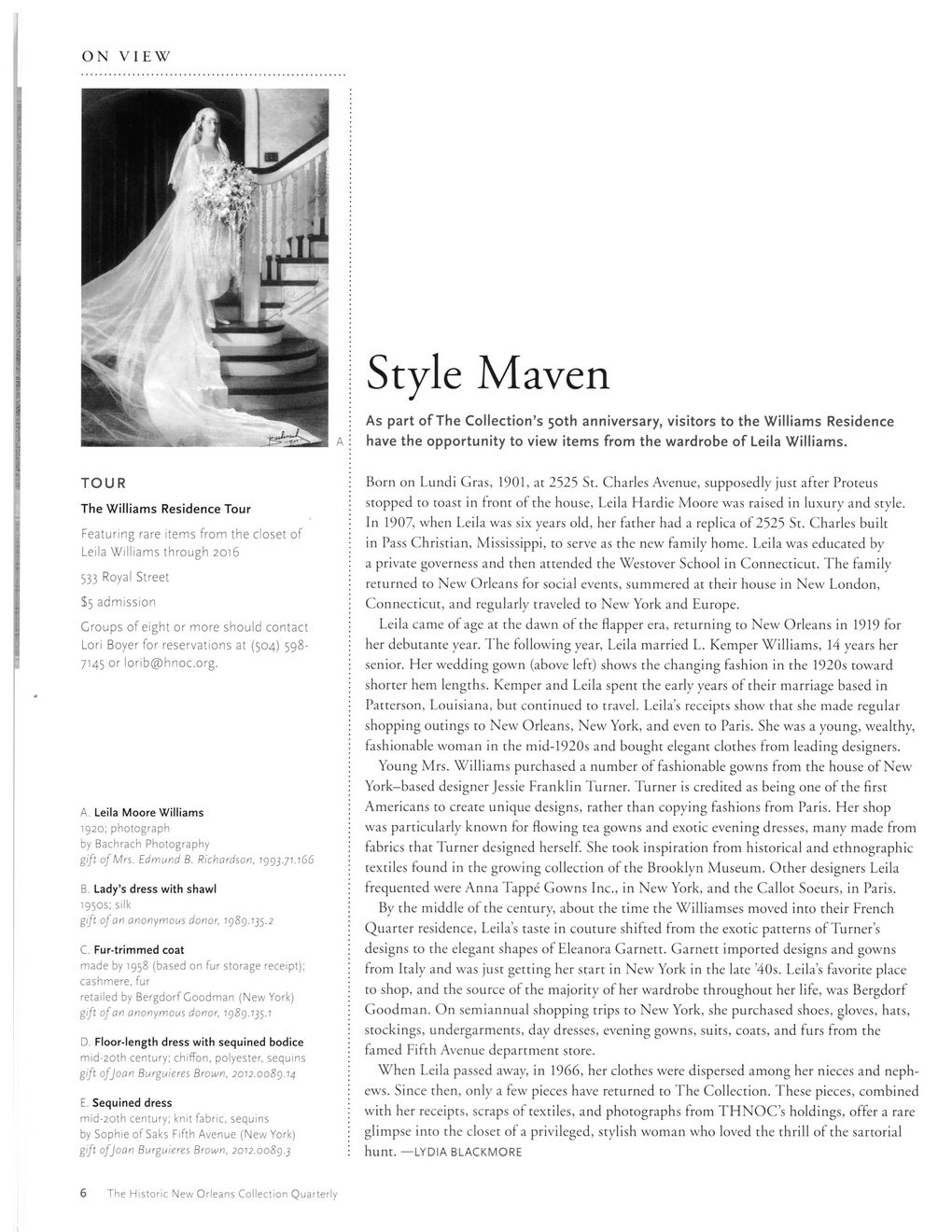This text was obtained via automated optical character recognition.
It has not been edited and may therefore contain several errors.
ON VIEW TOUR The Williams Residence Tour Featuring rare items from the closet of Leila Williams through 2016 533 Royal Street $5 admission Croups of eight or more should contact Lori Boyer for reservations at (504) 598-7145 or lorib@hnoc.org. A. Leila Moore Williams 1920; photograph by Bachrach Photography gift of Mrs. Edmund B. Richardson, 7993.77.166 B. Lady’s dress with shawl 1950s; silk gift of an anonymous donor, 1989.135.2 C. Fur-trimmed coat made by 1958 (based on fur storage receipt); cashmere, fur retailed by Bergdorf Goodman (New York) gift of an anonymous donor, 1989.135.1 D. Floor-length dress with sequined bodice mid-20th century; chiffon, polyester, sequins gift of Joan Burguieres Brown, 2012.0089.14 E Sequined dress mid-20th century; knit fabric, sequins by Sophie of Saks Fifth Avenue (New York) gift of Joan Burguieres Brown, 2012.0089.3 Style Maven As part of The Collection’s 50th anniversary, visitors to the Williams Residence have the opportunity to view items from the wardrobe of Leila Williams. Born on Lundi Gras, 1901, at 2525 St. Charles Avenue, supposedly just after Proteus stopped to toast in front of the house, Leila Hardie Moore was raised in luxury and style. In 1907, when Leila was six years old, her father had a replica of 2525 St. Charles built in Pass Christian, Mississippi, to serve as the new family home. Leila was educated by a private governess and then attended the Westover School in Connecticut. The family returned to New Orleans for social events, summered at their house in New London, Connecticut, and regularly traveled to New York and Europe. Leila came of age at the dawn of the flapper era, returning to New Orleans in 1919 for her debutante year. The following year, Leila married L. Kemper Williams, 14 years her senior. Her wedding gown (above left) shows the changing fashion in the 1920s toward shorter hem lengths. Kemper and Leila spent the early years of their marriage based in Patterson, Louisiana, but continued to travel. Leilas receipts show that she made regular shopping outings to New Orleans, New York, and even to Paris. She was a young, wealthy, fashionable woman in the mid-1920s and bought elegant clothes from leading designers. Young Mrs. Williams purchased a number of fashionable gowns from the house of New York—based designer Jessie Franklin Turner. Turner is credited as being one of the first Americans to create unique designs, rather than copying fashions from Paris. Her shop was particularly known for flowing tea gowns and exotic evening dresses, many made from fabrics that Turner designed herself. She took inspiration from historical and ethnographic textiles found in the growing collection of the Brooklyn Museum. Other designers Leila frequented were Anna Tappe Gowns Inc., in New York, and the Callot Soeurs, in Paris. By the middle of the century, about the time the Williamses moved into their French Quarter residence, Leila’s taste in couture shifted from the exotic patterns of Turner’s designs to the elegant shapes of Eleanora Garnett. Garnett imported designs and gowns from Italy and was just getting her start in New York in the late ’40s. Leila’s favorite place to shop, and the source of the majority of her wardrobe throughout her life, was Bergdorf Goodman. On semiannual shopping trips to New York, she purchased shoes, gloves, hats, stockings, undergarments, day dresses, evening gowns, suits, coats, and furs from the famed Fifth Avenue department store. When Leila passed away, in 1966, her clothes were dispersed among her nieces and nephews. Since then, only a few pieces have returned to The Collection. These pieces, combined with her receipts, scraps of textiles, and photographs from THNOC’s holdings, offer a rare glimpse into the closet of a privileged, stylish woman who loved the thrill of the sartorial hunt. —LYDIA BLACKMORE 6 The Historic New Orleans Collection Quarterly

New Orleans Quarterly 2016 Summer (007)